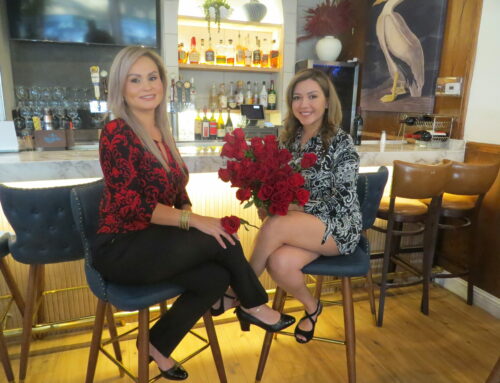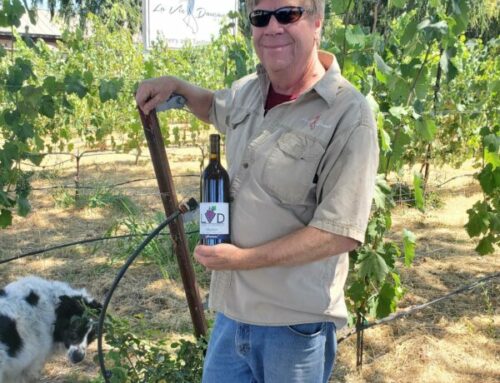Restaurant offers once-a-month dinners that pair tequilas with menu items
Published in the November 11-24, 2015 issue of Morgan Hill Life
By Marty Cheek

Photo by Marty Cheek
Miriam Vega holds a bottle of tequila. La Niña Perdida now serves tequila, mezcal, other distilled drinks and adult beverages with its meals.
La Niña Perdida chef Miriam Vega wants to educate patrons that there’s a more sophisticated way to taste and appreciate tequila. She’s on a mission to change the perception many Americans have of “Mexico’s national drink” and show them it’s far more than a college frat-house initiation drink or is only useful in making margaritas.
Since it opened a year ago, La Niña Perdida has grown a reputation throughout the Bay Area for serving high-quality traditional Mexican cuisine. It recently received its liquor license, allowing it to now serve patrons high-end tequila drinks.
“Little by little, our tequila inventory is growing, but we’re being very picky about what we put on our shelves because we want people to have a good experience with it,” Vega said.
La Niña Perdida has begun a once-a-month special dinner that pairs tequilas with selected menu items. In October, Vega invited an expert from the Clase Azul brand to educate diners on how to discover the “heart and soul” of its high-end tequilas produced in Mexico.
Tequila production has evolved in recent years where it is now filtered through carbon so that it comes out clearer and with a more polished taste, Vega said. This recent enhancement of quality has led to a trend of “refinement” to tasting tequila, she said. It is no longer just downed by consumers in a single shot but casually sipped to taste the smoother flavor, much like bourbon and whiskey are enjoyed.
“These tequilas are meant to be sipped,” Vega said. “Tequila has grown up a lot. And I think that’s the appeal of it now. It’s being produced differently. It’s being marketed differently. It’s not being marketed as a (college) spring break drink anymore. It’s being marketed to a more sophisticated crowd, people who can appreciate it as a fine alcohol that isn’t just meant for shots.”
Patrons at La Niña Perdida’s pairing dinners learn that the government of Mexico is working with tequila producers to sustain its blue agave used to make the distilled drink and protect this native plant from exploitation through overproduction.
“Mexico is having an issue with maintaining the agave and the integrity (of tequila), so now they want to do something good for the environment,” Vega said.
One aspect of tequila that Americans are finding fascinating is that tequila houses are taking an interest in the bottles that store their product. Some houses use a black clay to make their bottles and then hand-paint bottles or attach small beads to the outside to create one-of-a-kind containers. The hand-beaded knobs made for the bottles of one particular brand are considered by some aficionados as works of art and are collected.
“It’s not just the bottle that’s beautiful but what goes into the bottle,” Vega said. “So you have this incredible experience of drinking tequila.”
Tequila has traditionally been made at 40 percent alcohol, but in recent years, tequila houses have been producing it at 45 percent but still retaining the quality where the patron enjoys a smooth taste. And some boutique tequila uses the traditional methods of productions such as grinding the agave plant by hand. Moving away from mass production means there is more control of the product’s quality.
“We try to have the tequila served in its purest form at La Niña Perdida,” Vega said. “A lot of places serve tequila with the lime and salt, but with good tequila, you don’t need to.”
The restaurant instead serves sangrita, a non-alcoholic drink mixing tomato juice, orange juice, lime, sugars and a little bit of salt. Patrons find the tequila and sangrita accent each other when tasted one after the other.
“All your senses on your tongue are there when you sip tequila and then you sip sangrita,” Vega said. “It’s something that is served traditionally in Mexico outside of the resorts.”
For patrons who do want them, La Niña Perdida will serve margaritas using a traditional shaking method — no blenders allowed at the bar, Vega insists.
The restaurant also serves mezcal, a distilled alcoholic beverage made from the maguey plant grown in Mexico’s wilderness. Maguey is a different form of agave and is baked to a point where it produces a “very, very smoky” flavor compared with tequila, she said.
La Niña Perdida will serve a special Posada (a holiday honoring Mexico’s patron saint the Virgin of Guadalupe) dinner Dec. 9 with traditional holiday foods paired with tequila drinks to accentuate the flavor, Vega said.





